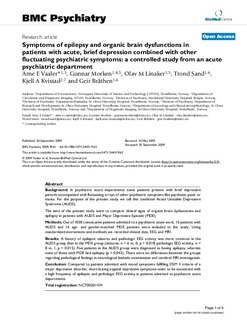Symptoms of epilepsy and organic brain dysfunctions in patients with acute, brief depression combined with other fluctuating psychiatric symptoms: a controlled study from an acute psychiatric department
Abstract
Background: In psychiatric acute departments some patients present with brief depressive
periods accompanied with fluctuating arrays of other psychiatric symptoms like psychosis, panic or
mania. For the purpose of the present study we call this condition Acute Unstable Depressive
Syndrome (AUDS).
The aims of the present study were to compare clinical signs of organic brain dysfunctions and
epilepsy in patients with AUDS and Major Depressive Episode (MDE).
Methods: Out of 1038 consecutive patients admitted to a psychiatric acute ward, 16 patients with
AUDS and 16 age- and gender-matched MDE patients were included in the study. Using
standardized instruments and methods we recorded clinical data, EEG and MRI.
Results: A history of epileptic seizures and pathologic EEG activity was more common in the
AUDS group than in the MDE group (seizures, n = 6 vs. 0, p = 0.018; pathologic EEG activity, n =
8 vs. 1, p = 0.015). Five patients in the AUDS group were diagnosed as having epilepsy, whereas
none of those with MDE had epilepsy (p = 0.043). There were no differences between the groups
regarding pathological findings in neurological bedside examination and cerebral MRI investigation.
Conclusion: Compared to patients admitted with mood symptoms fulfilling DSM 4 criteria of a
major depressive disorder, short-lasting atypical depressive symptoms seem to be associated with
a high frequency of epileptic and pathologic EEG activity in patients admitted to psychiatric acute
departments.
